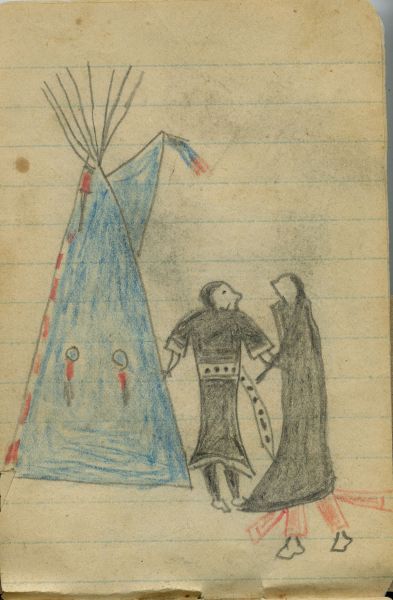COURTING: Man and Woman Stand before a Blue Tipi
Ethnographic Notes
Vertical COURTING: Man and Woman Stand before a Blue Tipi The tipi is decorated with two beaded circular pendant s and red markings. The man stands to the right, the woman in the middle, and the tipi to the left. The man has a long braid tied with otter ties (forked ends). In almost all of these profiled drawings, only one braid is visible. His solid-color blanket has a seam along the back and the lower edge. This cloth, also known as �saved-list cloth� was a common trade item, was made in England, especially the town of Stroud. �The principal characteristic of saved-list cloth was the undyed selvedges along both margins of the material,� and these were used as decoration (Benson Lanford, 2003: 147). This white stripe down the back resembles a skunk (see Plate 9 for discussion). His leggings and breech clout flap ends, which show under the blanket, are red, with undyed ends. The woman stands with her arms outstretched, and the arm closest to the man touches him. The woman�s dress is a solid dark color, probably stroud trade cloth, with undyed selvedge ends at the cuffs of the sleeves and the bottom hem of the dress. Dark leggings show under the dress and her feet are unshaded (bare). Both of these figures have moccasin-shaped feet, unlike many figures in the Dodge City 1879 ledgers where feet are abbreviated to be hoof-like (see discussion for Wild Hog-KSHS, Plate 2). Her belt appears to be cloth mounted with German silver conchos. The tipi has an open smokehole flap and eight poles. The circular ornaments on the tipi are rosettes: �Rosettes were usually anywhere from 4 to 8 inches in diameter and often a lock of hair or fur was inserted in the center. Four rosettes matched, but the fifth one attached at the back of the cover just below the tie point on the lift pole. It was usually bigger or of a different design and shape, trapezoidal or rectangular. Rosettes were placed in a southeast, southwest, northwest, and northeast direction if the tipi was facing east at a height of about 6 to 8 feet. This height varied with the makers. Cheyenne, Arapaho, Kiowa, Gros Ventres, Shoshone, and Ponca tribes used these and similar types of adornments� (Linda Holley, 2007: 142). The first documentation of these tipi �tinklers� or rosettes was 1811 (Holley, 2007: 143). Two of the rosettes are out of view, on the far side of the tipi. The seam of the tipi also has quill or beadwork, in red and white.

